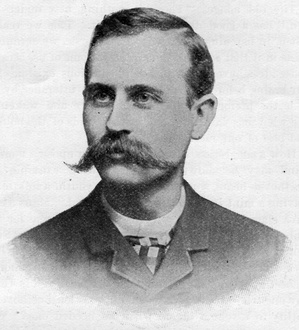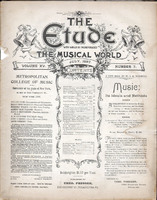 E. M. Sefton was born in Benton County, Iowa, on the ninth of October, 1859. Love of music was early manifested in him, as he commenced its study when thirteen years of age. During the progress of his musical education he studied the piano with Oscar Mayo, Wm. H. Sherwood, and Dr. Louis Maas; the organ with Eugene Thayer; harmony and composition with Stephen A. Emery, and Eugene Thayer, and Dr. Mass.
E. M. Sefton was born in Benton County, Iowa, on the ninth of October, 1859. Love of music was early manifested in him, as he commenced its study when thirteen years of age. During the progress of his musical education he studied the piano with Oscar Mayo, Wm. H. Sherwood, and Dr. Louis Maas; the organ with Eugene Thayer; harmony and composition with Stephen A. Emery, and Eugene Thayer, and Dr. Mass.
He settled in Cedar Rapids in 1881, when he was invited to fill the chair of Director of Music in Coe College. In 1885 he was elected Vice-President of the Music Teachers’ National Association, which office he held for four years, when he voluntarily relinquished it. It was through his earnest effort that the State Music Teachers’ Association was organized, and his inspiration gave it a lusty life.
It was largely through Prof. Sefton’s personal exertions that the Cedar Rapids Academy of Music was established, and it became the first incorporated music school in the State. After serving as its director for two years, ill health compelled him to relinquish his position. After a rest of five years, and at the urgent request of his musical friends, he assumed the directorship of the Liszt Music School, which position he now holds.
“The time was when we were not, but never will be again.”
Are you helping old Father Time in the untying of one of those wonderful child bundles? Be wise, then, and patient, too, lest you miss some packages containing gems of rare worth; lose none in their manifold wrappings; let none be kept in the folds of Time’s wrinkled garment; take care that all be brought to light, that the pearls may be polished, the diamonds cut, the rubies burnished, and the gold refined. The child is plastic clay, while man has passed from the potter’s hands; the child is the alpha, man, the omega, of life; the child is a possibility with a probability, man only a doubtful possibility.
Every conscientious teacher is much concerned about this bundle of possibilities—the child. How can we best get hold of it? How can we get the most out of it? Where shall we dive for white, translucent, lustrous pearls? How shall we cut these “diamonds in the rough” that they best glimmer in the ”time” light, and glitter in the “eternal” day? To answer such questions in detail would involve the careful study of each individual child, for each has a personality, an individuality, as marked in the mind as in the face. To recognize and deal with these individualities is the special work of every teacher; to speak of generalities or common traits and characteristics is the purpose of this study, trusting that by so doing we may stimulate teachers to a more careful study of the individual, for to teach a dozen children well, one must be a dozen different teachers. Our labor is great in proportion to the magnitude and importance of the subject treated, viewed in its relation or bearing on the real issues of life. If we appraise child-life at its real value, we shall see that it holds all values of the future; it is the soil in which the good, the true, and the beautiful are to be propagated. Through childhood is the road to all improvement and progress. Shall
we be true or false to our trust? It is easier to add virtue than to subtract vice, and the way to suppress the ugly is to exalt the beautiful.
Much more than half of our population is in the children’s kingdom; they are in a plastic condition, sensitive to not only the best but the slightest influence. Shall we touch and lift them? We are writing the laws and the history of the future in the child-life of to day.
Activity.
Say “do” instead of “do n’t.”
A healthy child is the most forceful illustration of life. A veritable perpetual motion; an engine with the steam-gage registering 100 pounds pressure. Doing is the only safety-valve; keep it open unless you wish an explosion. Force finds equilibrium only in motion; you may dig new courses for the cataract, but you can never successfully confine it.
An inactive child is an imbecile. There are degrees of activity in healthy children, and these degrees are usually prophecies of future usefulness or uselessness, as they are properly or improperly directed. If you would have a child a “know-nothing,” the “do-nothing” policy will produce it. Activity is the manifestation of energy, the indication of inherent power,—an expression of strength. Shall this energy be directed on the things that are worth while or on vanities? Shall we see that this strength develops until it becomes a resistless force with which to meet the obstacles of life?
Activity is potent, not passive. It communicates action; it produces effects. To suppress activity is to enervate life, to weaken the will and deteriorate growth. An active life develops strength for the emergency, vigor for the life marches, and victory in the conflict. Activity shows an ambition to be awakened. What wealth is not suggested in the child’s spontaneity? Like all great natural forces we need but work in harmony with their inexorable laws to get mighty results. History is the record of activity, not of speculation.
What is to be done with this jumping-jack boy and romping girl? The answer is found in one word—employment; to furnish this is one of the teacher’s life-tasks; neglect is the deadliest of weapons, and the worst of offenses. We ask bonds from those who handle our sordid gold. What bonds shall we require of those who deal in soul futures? “Tools become wonderful only as they are skilfully handled; let the wrong person wield the brush or handle the chisel and a daub and a broken shaft are the result.” We are working on statues more lasting than marble; success means a glory in proportion. Let us paint famous pictures; let us write great dramas—but avoid the tragedies; let us write epic poems; let us compose the stately overtures and the sublime symphonies of to-morrow in the hearts of the young of to-day.
Curiosity.
Curiosity is a fire that can be quenched only with information; it is, therefore, the hand-maid of the educator. Curiosity prompts investigation. It leads in the search for all truth. It should be inscribed on the banner of the discoverer, philosopher, mathematician, judge, moralist, and divine. Create in the child a disposition to inquire after any truth, and the truth is half taught. Arouse curiosity and you capture attention, and this is essential to the earnest consideration of any subject. We may speak to a deaf mute, but nothing is heard; we may talk to a preoccupied mind, but nothing is learned. Where there is a consuming curiosity we get not only a concentrated but a continuous and inquiring attention. Every curious child becomes an animated interrogation point. No Athenian was ever more industrious in seeking out “some new thing” than is the normal child.
Questions and answers are the rolling stock in the transportation and exchange of thought and knowledge. Questions are probes for facts—mustard plasters that draw out what there is within. Did you ever have a child apply them? You must direct this search for truth; never allow the child to say, even mentally, “I called but ye gave me no answer,” for, “as in water face answereth to face, so the heart of man to man.”
Imagination.
Imagination is one of the strongest traits of childhood; at no other time in life is it so vivid or intense. Imagination transforms a straight mark into a man, a rag doll into a thing of life, a playhouse into a palace, and the dullest lesson into an hour of pleasure. Imagination is the highway of approach to the interest of the pupil. It produces or rather reproduces any object of the sense previously perceived and is the power that recalls any mental condition or spiritual state that has before been experienced; it is the image-making power of our being; it is the great constructive and creative power in man. From several reals the ideal is formed; let the child read the lives of half a dozen great men and the imagination, by its combining power, will build its ideal of greatness and goodness from the sum of the admirable traits found in the men studied. So we get our ideals of a sonata or symphony after hearing it by a dozen artists. Let us fill the minds and lives of the young with such matter that their on-building shall be of indestructible materials and on a sure foundation. The active imagination will vary and combine ideas in the memory into new forms and relations; novelty, invention, and originality is the outcome. “Something new” always proves to be something very old in new relations. “There is nothing new under the sun,” but there is no limit to new relations of the old, under the reconstructive and creative power of the imagination. Imagination is the guiding power in art; of art in its most comprehensive sense; all that is included in beauty, whether in architecture, sculpture, painting, poetry, or music. That magnificent poem in stone, the Cathedral at Milan, first had a being in the thought of the architect, planted there by the creative power of the imagination. The Venus of Milo in all its Comeliness and beauty was seen imprisoned in the rough marble shaft long months before the sculptor’s releasing chisel touched its shapeless sepulcher: here we have again the image- making power of the imagination. Much in art is suggestive and therefore incomplete without the filling-in power of the imagination. We must call on it to complete the picture. The romantic school of music is but a blank canvas to the one with undeveloped imagination, but an endless panorama of exquisite pictures to the one that has this inner vision; things unknown take form, and airy nothing is given a name and habitation.
Let us develop greatness in ideals, ingenuity and novelty in the creative powers, and an appreciation of beauty in all its fields by encouraging a preservation and enlargement of a healthy imagination.



